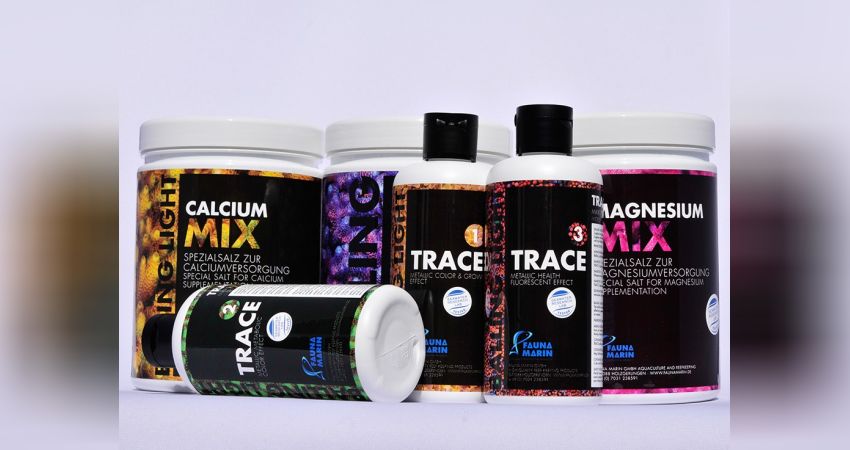How a marine aquarium is created-Part 18: Supply KH, calcium and magnesium

After a short time after starting the saltwater aquarium, you have to think about how to keep the values up to date. The lime reactor and the balling method are particularly well known here. Lime water was common in the past, but hardly anyone uses it any more.
Stone corals, mussels but also the much desired calcareous red algae need calcium and carbonates to build up their skeletal structures. With constant growth of the corals, they withdraw these important minerals from the water. Therefore, there is a constant consumption of calcium and carbonates in the aquarium. If we do nothing, this leads to a growth stop and in the long run even to the death of stony corals. A water change is usually not sufficient to supplement the deficiency.
It is known that calcium and carbonates are actually needed in the aquarium.
Three methods are actually known:
- the lime water method according to Wilkens (calcium hydroxide solution)
- the lime reactor
- the Balling method
The lime water method (calcium hydroxide)
Calcium hydroxide is, in simplified terms, a substance made of calcium (Ca), oxygen (O) and hydrogen (H).
The lime water method only provides calcium, but no carbonates. If you would like to read up on lime water, you are welcome to do so at the link in our archive. There is a very good paper by Lars Sebralla on the subject of lime water, lime reactor or even both together: Link ARCHIVE:
.
The lime reactor:
The lime reactor is a technical process that does not always work optimally in all aquariums.
In the lime reactor, carbon dioxide gas (CO2) is brought into solution to split the lime particles into their components, i.e. calcium and carbonate. However, CO2 itself reacts with water to produce carbonic acid, which further increases the carbonate hardness. This can cause an imbalance between the calcium and the carbonate, so that immediately after the lime reactor the lime dissolved in the reactor chemically precipitates again in the aquarium. The release of the residual CO2 into the aquarium can also lead to undesirable algae growth.
The Balling Method:
The method is named after its inventor Hans Werner Balling, as well as other publications around 2000 to 2001, among others in the journal Der MeerwasserAQUARIANER. I think there were several relevant publications at that time, one by Erwin Renke and of course the one by Hans-Werner Balling himself. This was later followed by a simplified publication by Stefan Lindner, an aquarist. It is fair to say that this method has become quite established worldwide.

The balling method is used to supply the marine aquarium with calcium (Ca), carbonate hardness (KH) and trace elements. The advantage of the balling method is a consumption-dependent addition of Ca, KH and trace elements. This balling method was modified by FaunaMarin many years ago and is now called the Balling Light method.
The Balling Light method is a method of adding Ca, KH and trace elements.
Here you can see the video for mixing:
.
Before starting thedaily dosing, one should optimally bring all values to the setpoint.
Start adding the 3 solutions first with correct water values.
.The optimum values are for:
.KH: 7° - 8°
.Ca: 420mg - 440mg/litre
.Mg: 1290 - 1350 mg /litre
.The daily addition of the 3 parameters depends on the consumption and must always be considered separately in the Balling Light System.
The Aqua Calculator (www.aquacalculator.com) is a very helpful programme that can help you with this. There you can enter the measured values and the calculator will calculate the exact amount to add.
So bring everything up to date, then measure Ca, MG and KH after one day.
Enter the changed values and the programme will tell you what to add.
Of course, it makes real sense to automate the whole thing in the long run with a dosing system. The market offers many simple but also more expensive devices.
You will certainly have to measure more often in the beginning, as calcium and KH, for example, consume more than magnesium. In the case of MG, it is sufficient later to calculate and dose the amount to be added every week or even every second week, as magnesium is consumed much more slowly than calcium. This means that the amounts added here are much smaller than, for example, for the KH.
The addition times are calculated and dosed every week or even every second week.
By the way, the addition times are not relevant. You should just not add calcium and KH together. It is best to leave at least a 10-minute break between doses.
The 3 liquids have a long shelf life. A brown colouration of the calcium solution is normal.
How do you like this article?
Info
Author

Bookmark
Comments
Topics
Similar articles
- 25 - Small polyp stony corals
- 19 - UV clarification
- How a marine aquarium is created Part 38: When corals become entangled, the fight for settlement space
- How a marine aquarium is created Part 47: The Armatus 400 after 30 months
- How a marine aquarium is created Part 30: Fish, corals, night shots
- 02 - Choosing the right seawater aquarium
- How a marine aquarium is created-Part 23: The water level - drain problem in the marine aquarium
- 23 - Crustose disc anemones and soft corals:
- 14 - Part 1 Filter systems - DSB
- Photographing under blue light - 4 clip filters in comparison
Comments To the top
Please register
In order to be able to write something yourself, you must register in advance.






